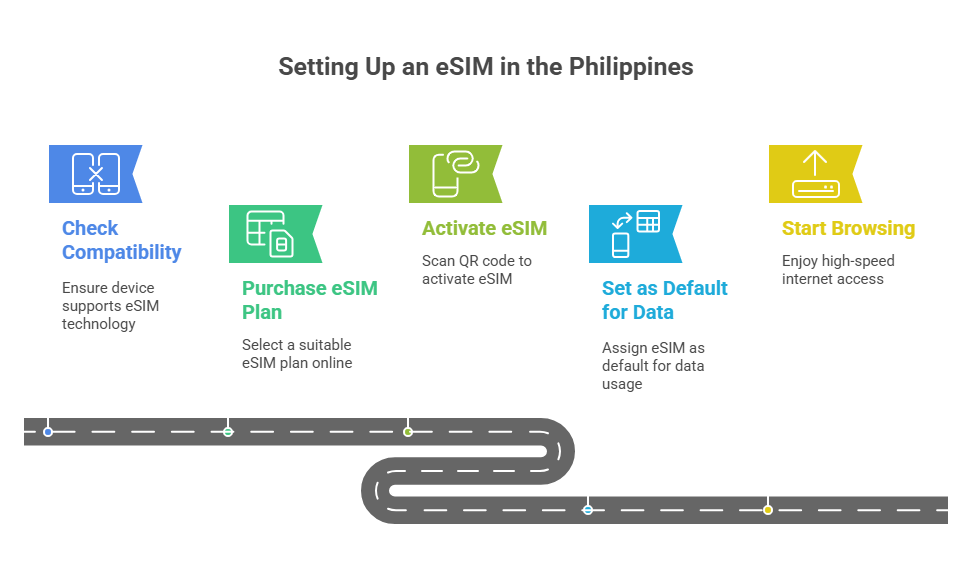Enter eSIM technology—a game-changing solution that offers convenience, flexibility, and cost-efficiency for travelers like you.
This guide walks you through everything you need to know about using eSIMs in the Philippines, including setup, pricing, use cases, and FAQs. By the end, you’ll be ready to choose the perfect plan for your trip.
What is an eSIM, and Why Use It in the Philippines?
An eSIM, or embedded SIM, is a digital alternative to a physical SIM card. Instead of swapping out tiny plastic cards when traveling, eSIMs allow you to download a mobile plan directly to your phone. Many modern smartphones, tablets, and laptops support this technology, making it perfect for hassle-free connectivity.
Here’s why travelers are increasingly opting for eSIMs in the Philippines:
- Convenience: Skip long lines at telecom stores—activate your eSIM instantly upon arrival.
- Flexibility: Load multiple plans on your device and switch seamlessly between them.
- Wide Coverage: Many eSIM providers offer plans with robust coverage throughout the Philippines, from city centers to remote islands.
- Cost-Efficiency: Avoid roaming fees with prepaid eSIM data plans that suit your budget.
Whether you’re a digital nomad, business traveler, or vacationer, an eSIM saves you time and effort while ensuring you’re always connected.

How Much Does an eSIM Cost in the Philippines?
eSIM pricing in the Philippines varies depending on the provider, amount of data, and validity period. On average, you can expect to pay:
- $5–$10 for 1GB of data, valid for 7 days
- $15–$25 for 3GB–5GB, valid for 15–30 days
- $40+ for unlimited data plans, often valid for 30 days
These prices are often more competitive than international roaming charges offered by traditional carriers. Additionally, many eSIM providers allow you to top up or purchase add-ons without starting a new plan.
Pro tip: Compare eSIM plans through trusted platforms like Terminal eSIM to find the best rates and coverage options.
How to Set Up an eSIM for the Philippines
Setting up an eSIM is quick and user-friendly. Just follow these steps:
1. Check Compatibility
Ensure your smartphone or device supports eSIM technology. Popular models like the iPhone 14 series, Google Pixel 7, and Samsung Galaxy S23 are compatible.
2. Purchase an eSIM Plan
Browse eSIM plans for the Philippines on platforms like Terminal eSIM. Select the one that fits your data needs.
3. Activate the eSIM
After purchase, you’ll receive a QR code via email or on the provider’s website. Open your phone’s settings, scan the QR code, and follow the prompts to activate.
4. Set as Default for Data
Go to your device’s mobile network settings and assign your eSIM as the default for mobile data usage.
5. Start Browsing
Once activated, your eSIM connects to a local partner network, giving you instant access to high-speed internet in the Philippines.

Use Cases for eSIMs in the Philippines
Still unsure if an eSIM is right for you? Here are real-life scenarios where an eSIM can enhance your experience:
For Travelers
Whether you’re hopping between islands or exploring historical landmarks, an eSIM keeps you connected with reliable data. Use it to access maps, book transport through apps, or share your adventures in real-time on social media.
For Digital Nomads
If work follows you wherever you go, an eSIM provides a secondary line for uninterrupted internet access. Many plans offer wide 4G LTE coverage across the Philippines, from coworking spaces in Cebu to beachfront cafés in Palawan.
For Business Travelers
Attending meetings or conferences in Manila? Use an eSIM to ensure uninterrupted email access, video conferencing, and secure data sharing without worrying about public Wi-Fi.
For Expats and Long-Term Visitors
Planning to stay for a few months? eSIMs offer the flexibility to repurchase or switch plans without the hassle of physical SIM cards. Prepaid options allow you to control costs effectively.
Frequently Asked Questions About eSIMs in the Philippines
1. Is eSIM access available across the entire Philippines?
Yes, eSIM-compatible networks cover most urban areas and popular tourist destinations. Availability may vary in remote locations.
2. Which devices support eSIMs?
Latest smartphones, such as the iPhone XS and newer, select Google Pixels, and Samsung Galaxy models like the S21, support eSIM.
3. Can I use an eSIM for calls and texts?
Yes, eSIMs support voice and text services, but their primary use is for mobile data. Use internet-based services like WhatsApp or Messenger for international calls.
4. How do I top up my eSIM plan?
Most eSIM providers allow users to purchase additional data directly from their websites or apps.
5. Can I switch between multiple eSIMs on one device?
Absolutely! Your device can store several eSIM profiles, though only one can be active at a time.
Why Choose Terminal eSIM?
At Terminal eSIM, we simplify connectivity for global travelers. Our platform aggregates affordable eSIM plan options for the Philippines, backed by reliable customer support and extensive coverage. Compare plans, activate your eSIM instantly, and enjoy your trip without worrying about staying connected.
Now’s the time to make your travel setup seamless. Explore the best eSIM plans for the Philippines today, and ensure you’re always online—wherever your adventure leads.



